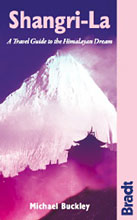Shangri-La: A Travel Guide to the Himalayan Dream

208 pages plus 48pp colour photos
Shangri-La is one of the most evocative myths of our time — so powerful that it has entered the dictionary as a synonym for paradise. As myths go, it is a young one: Shangri-La made its debut with the 1933 publication of British author James Hilton's novel, Lost Horizon. No sooner was Shangri-La created by Hilton than a host of places staked claims to being the real location that inspired the book.
This guide to the mythical site of Shangri-La is rooted in the glorious reality of the Himalaya, encompassing parts of southwest China, Tibet, Bhutan, Nepal, Sikkim and Ladakh. It forms a concise guide to the most remote areas of the region, with a focus on major mountain peaks, and some well-chosen treks in each area. Practical information and maps will ensure that visitors can make the most of their trip to this other-worldly destination, while armchair readers can browse and dream…
- First and only guide on the market blending exploration of the myth with practical advice on visiting the contested sites
- Focus on the region's legendary sacred peaks and monasteries, including acclimatisation hikes, as well as tougher treks
- Provides background on oddball adventurers and seekers of lost kingdoms of the Himalaya
- Sidebars on esoteric topics like Tracking the Yeti (Bhutan) and Crazy about Hockey (Ladakh)
- Illustrated wildlife appendix — a concise field guide to the most unusual animals
- Extended colour photo sections to illustrate the concept of Shangri-La
MYTHBUSTERS
ARE these FACT or MYTH?
- in 2002, Beijing officially recognised five counties in southwest China as being the actual location of Shangri-La
- a national park to the east of Bhutan is set aside for yetis
- bar-headed geese can traverse Himalayan peaks, flying at over 8,000 metres and enduring temperatures down to minus 70° Celsius
- the Holy Grail of Tibet is a parasitic fungus that takes over a moth—and is highly valued for its medicinal properties
- the book The Five Tibetans describes secret exercises smuggled out from a Tibetan monastery—and guaranteed to make you look 20 years younger
- in the 1920s, monks at Rongbuk Monastery said that any attempt to summit Everest would disturb the resident goddess, who would surely cast the climbers down
- in 1933, the New York Times reported the death of a Chinese herbalist at the amazing age of 256
FIND OUT more about the weird and wonderful Tibetan world in Shangri-La: A Travel Guide to the Himalayan Dream
